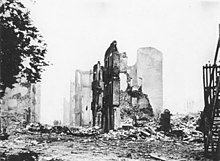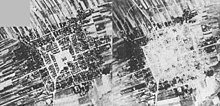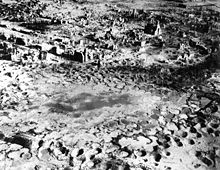This article needs additional citations for verification. (January 2013) |




The aerial bombing of cities is an optional element of strategic bombing, which became widespread in warfare during World War I. The bombing of cities grew to a vast scale in World War II and is still practiced today. The development of aerial bombardment marked an increased capacity of armed forces to deliver ordnance from the air against combatants, military bases, and factories, with a greatly reduced risk to its ground forces. The killing of civilians and non-combatants in bombed cities has variously been a deliberate goal of strategic bombing, or unavoidable collateral damage resulting from intent and technology. A number of multilateral efforts have been made to restrict the use of aerial bombardment so as to protect non-combatants[2] and other civilians.
- ^ Daniel Blatman, Rachel Grossbaum-Pasternak, Abraham Kleban, Shmuel Levin, Wila Orbach, Abraham Wein (1999). translation Volume VII, Yad Vashem, pp. 406–07. Archived 2016-03-03 at the Wayback Machine
- ^ "International Law on the Bombing of Civilians". Archived from the original on 2013-03-11.
© MMXXIII Rich X Search. We shall prevail. All rights reserved. Rich X Search
